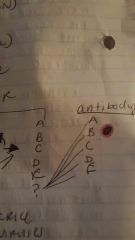![]()
![]()
![]()
Use LEFT and RIGHT arrow keys to navigate between flashcards;
Use UP and DOWN arrow keys to flip the card;
H to show hint;
A reads text to speech;
24 Cards in this Set
- Front
- Back
|
Taxonomy |
Science of classification |
|
|
Systematics |
-Evolutionary taxonomy -phylogenetic hierchy (tree) |
|
|
Early systems used physical characteristics |
-cell structures -nutrition -5 kingdom system Prokaryotes: no nucleus, bacteria Eukaryotes: nucleus, membrane, human |
|
|
Molecular techniques now used (805) |
Look at DNA, RNA, and other Cell chemicals (chemical breakdown) -3 domain system |
|
|
The three domains |
Developed by Carl woese (1978) Based on rRNA sequences -rRNA found in ribosome in all cells -there are 3 kinds of rRNA in all living things |
|
|
3 domains above kingdoms level |
Bacteria Archaea Eukarya |
|
|
Eukarya |
Eukaryotic, single and multicellular |
|
|
Kingdoms within eukarya |
-prorista: algae (plantlike) & protozoa (animallike) simple single called organism -fungi: molds and yeasts (not complex--feed on dead organic material) -plantae: multicellular plants -animalia: multicellular animals ^ both complex multicellular |
|
|
Bacteria |
-Prokaryotic, single called -Archaea and bacteria -cell wall contains peptidoglycan (cell wall) -sensitive to antibiotics (have their own ribosome RNA) - includes pathogenic Prokaryotes, cyanobacteria and nonpathogenic bacteria |
|
|
Archaea |
-Prokaryotic, single celled -they used to be considered bacteria -no peptidoglycan in cell wall -rRNA different from bacteria -no antibiotic sensitivity -example:hyperthermophiles |
|
|
Archae |
They don't cause disease We don't really come in contact with them They're in hydrothermal vents- deep in the ocean (hot magma) only.placr they live and survive |
|
|
The levels of classification |
-kingdom (animalia) -phylum (chordata) ex fish, bird, grizzly bear etc -class (mammalia) ex. Pig, grizzly bear -order (carnivora) ex. Dog, panda. Black bear, grizzly bear -family (ursidae) ex. Panda, black bear, grizzly bear -genus (ursus) black bear, grizzly bear -species (horribilis) grizzly bear |
|
|
Scientific nomenclature |
- two name system for naming specific organisms -bionomial -developed by carolus linnaeus (1700s) -uses latin |
|
|
Scientific nomenclature |
Uses latin Genus: Bacillus Specific epithet: anthracis Species: Bacillus anthracis *always underline/italicized both parts *first letter of the genus is always capitalized It's in Latin, because there were so many different names for the same species because of the language barrier - latin was most common of people knowing |
|
|
Strains |
Recent concept -slightly different than other member of the species E.coli: 0157: H6 (hemorrhagic E. Coli) We don't have this specific e.coli in our system.. in cows and that 1 extra gene codes for toxin and can poison us We all have e.coli in our intestines.. all are unique. Different for each genepool |
|
|
Methods of taxonomy |
Specific to bacteria -morphological characteristics -shape, size, arrangement of cell |
|
|
Differential staining |
Gram stain Endospore Capsule, etc Structures some cell have but some do not |
|
|
Gram stain |
Gram positive (purple) Gram negative (pink) Differentiates cell wall type |
|
|
Biochemical tests |
-metabolism (usually fermentation) -rapid identification methods |
|
|
Metabolic test at end of semester |
High end tests Seriology, phage typing, nucleic acid hybridization |
|
|
Serology |

-match antibody to pathogen -Europe. Lisa test (50 of these at once) salmonella |
|
|
Phage typing |
Match virus to specific bacteria Similar to serology but using viruses |
|
|
Nucleic acid hybridization |
-DNA probes AATTCCGGATAT TTAAGGCCTATA (PROBE] Take unknown sample/heat it up, add probe- it will attach and it will glow if that sequence of DNA is in there- identify strand -DNA chips- a slide there they can put 20 probes |
|
|
DNA fingerprinting |
-compare DNA sequences -add chemicals to cut strips -same strain if the cut and sizes are the same |

